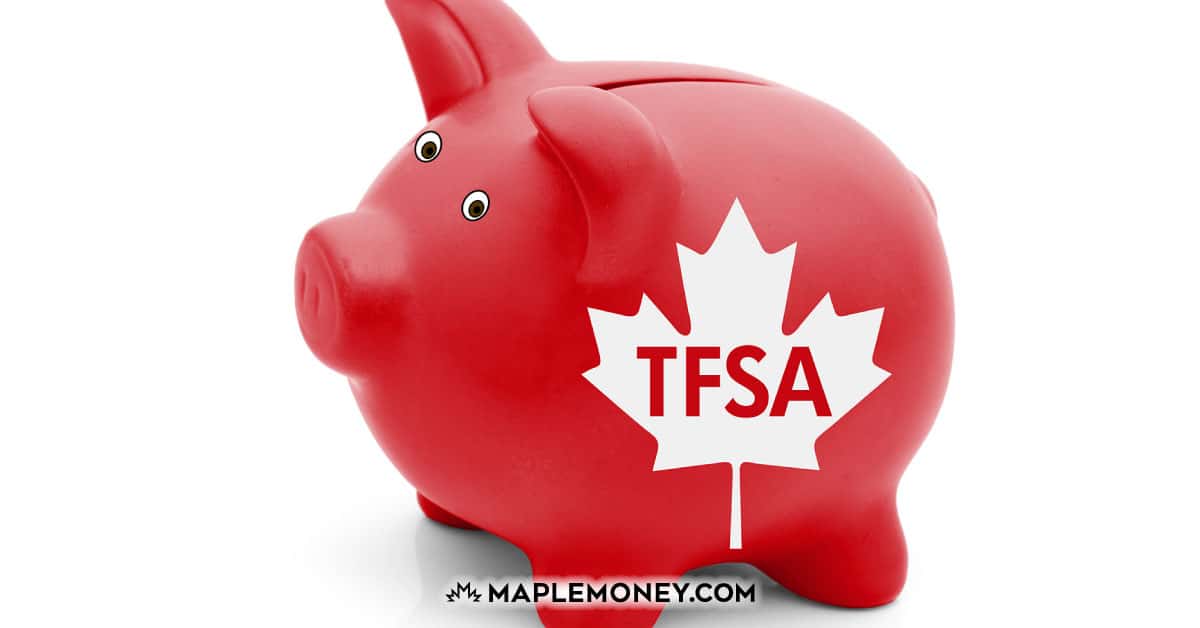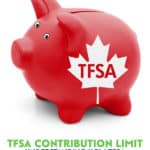TFSA Contribution Limit: Understanding How TFSA Contributions Work

The Tax-Free Savings Account (TFSA) has been around since 2009, but many Canadians remain unaware of the rules surrounding contribution limits. What’s the annual TFSA dollar limit? Can you carry forward the unused contribution room? How are overcontributions handled? And how do you find your available TFSA contribution room? Keep reading as I answer these questions, and more.
How the TFSA Works
The Tax-Free Savings Account is a registered savings plan that the Canadian government launched in 2009. The name is a bit misleading, as the account is much more than a traditional savings account. Inside a TFSA, you can buy several investments, including guaranteed investment certificates (GICs), mutual funds, stocks and bonds, ETFs, and more.
The money you deposit into a TFSA is considered after-tax dollars. Not only does the money grows tax-free in the account, but when it’s withdrawn, there are no tax penalties applied. This is different than another tax-sheltered investment vehicle, the RRSP. Accountholders receive a tax deduction on their annual contributions with an RRSP, but they have to pay income tax on the total amount when they withdraw funds. RRSPs and TFSAs each have their pros and cons.
Current Year TFSA Contribution Limit
For 2022, the annual TFSA limit is $6,000. If you’ve never deposited to a TFSA, you can contribute up to $81,500 if you were 18 years of age or older in 2009. Except for 2015, annual limits are indexed to inflation and rounded to the nearest $500.
TFSA Contribution Limits by Calendar Year
I’ve included the annual contribution limits for the TFSA below, starting in 2009. Your TFSA contribution room begins to accumulate in the year that you turn 19. For example, if you turned 19 in 2018, your lifetime contribution limit would be $23,500 as of 2022.
| Year | Contribution Limit |
|---|---|
| 2009 | $5,000 |
| 2010 | $5,000 |
| 2011 | $5,000 |
| 2012 | $5,000 |
| 2013 | $5.500 |
| 2014 | $5.500 |
| 2015 | $10,000 |
| 2016 | $5,500 |
| 2017 | $5,500 |
| 2018 | $5,500 |
| 2019 | $6,000 |
| 2020 | $6,000 |
| 2021 | $6,000 |
| 2022 | $6,000 |
| Lifetime Limit | $81,500 |
Who Can Contribute to a TFSA?
If you are at least 18 years of age, are a resident of Canada, and have a valid Social Insurance Number, you can contribute to a TFSA. Non-residents 18 and over with a SIN number can also contribute, but if you make contributions while a non-resident, you will be charged a 1% tax every month that the contribution remains in the account. In other words, don’t contribute when you’re not living in Canada.
How Do TFSA Withdrawals Work?
We’ve covered contributions, what about TFSA withdrawals? You can withdraw funds at any time (in accordance with the rules of the underlying investment) with no tax implications. However, if you make a withdrawal, you must wait until January 1st of the next calendar year to recontribute the funds. Here’s an example:
Let’s say that you’ve made the maximum contribution to your TFSA every year since 2009, including the current year. For illustration purposes, let’s assume that you have a current TFSA account balance of $81,500.
You decide that you want to withdraw $20,000 to pay for some home renovations. You can re-contribute the $20,000 at a later date, but it must be on or after January 1st of the following calendar year.
In this situation, your contribution limit for 2023 would be $26,600, assuming no change in the annual limit.
How Are TFSA Overcontributions Treated?
Like an RRSP, it is possible to overcontribute to your TFSA account. Unfortunately, financial institutions aren’t equipped to know your TFSA contribution limit. You are responsible for checking your limit with the Canada Revenue Agency, either through My Account online or on your annual Notice of Assessment, to ensure you don’t go over your maximum amount. This is also where you can locate any unused TFSA contribution room.
TFSA Overcontribution Penalty
If you overcontribute, the CRA will dock you 1% per month on the excess amount, until you return your account within the proper limit. This can happen by you withdrawing the excess funds or waiting until the next calendar year when the limit increases.
Example:
Let’s say that your total contribution limit, including unused contributions from previous years, is $14000. In August of 2021, you inadvertently deposited $20,000 into your TFSA, an over-contribution of $6000. The CRA would assess a 1% penalty per month ($60) until you are back within your allowable limit. So, if you waited until January 1st, the new $6000 limit will take effect, but not before you pay a 1% penalty X 5 months.
That’s $60 X 5= $300
In other words, a significant amount and an expense you want to avoid.
Where Can I Open a TFSA Account?
If you don’t currently have your own Tax Free Savings Account, there are several ways you can open one. All banks and credit unions have TFSA accounts available, but, in most cases, you will have to visit a branch in-person to complete the account opening process.
If you don’t mind the DIY approach, I recommend opening a TFSA account with an online discount brokerage, like TD Direct Investing, Wealthsimple Trade, or Questrade. This way, you can hold just about any investment type without leaving your living room.
Another option is to go with a robo-advisor TFSA account, like the one offered by Wealthsimple. A robo-advisor guides you through a series of questions to let you build a customized portfolio. The result is a completely hands-off investment solution.
Final Thoughts on TFSA Contribution Room
Now that you have a better understanding of how TFSA contribution room works, you may be wondering if it’s better to contribute to a TFSA or an RRSP? It’s a question people often ask me. While everyone’s situation is different, I believe that most Canadians should contribute to both types of plans.
Generally speaking, higher-income earners will benefit more from the tax-deductibility of an RRSP, but the TFSA is a more flexible product for everyone. RRSPs are designed solely as a retirement savings vehicle unless you plan to use the Home Buyer’s Plan (HBP) or Lifelong Learning Plan (LLP). A TFSA, on the other hand, can be used for any savings goal, including retirement.


Comments
In your calculation 20000 was withdrawn next year contribution room would be 26000 not 26600. Unless I mis understand this example.
Jim